Sukhothai, the cradle of Thai civilisation
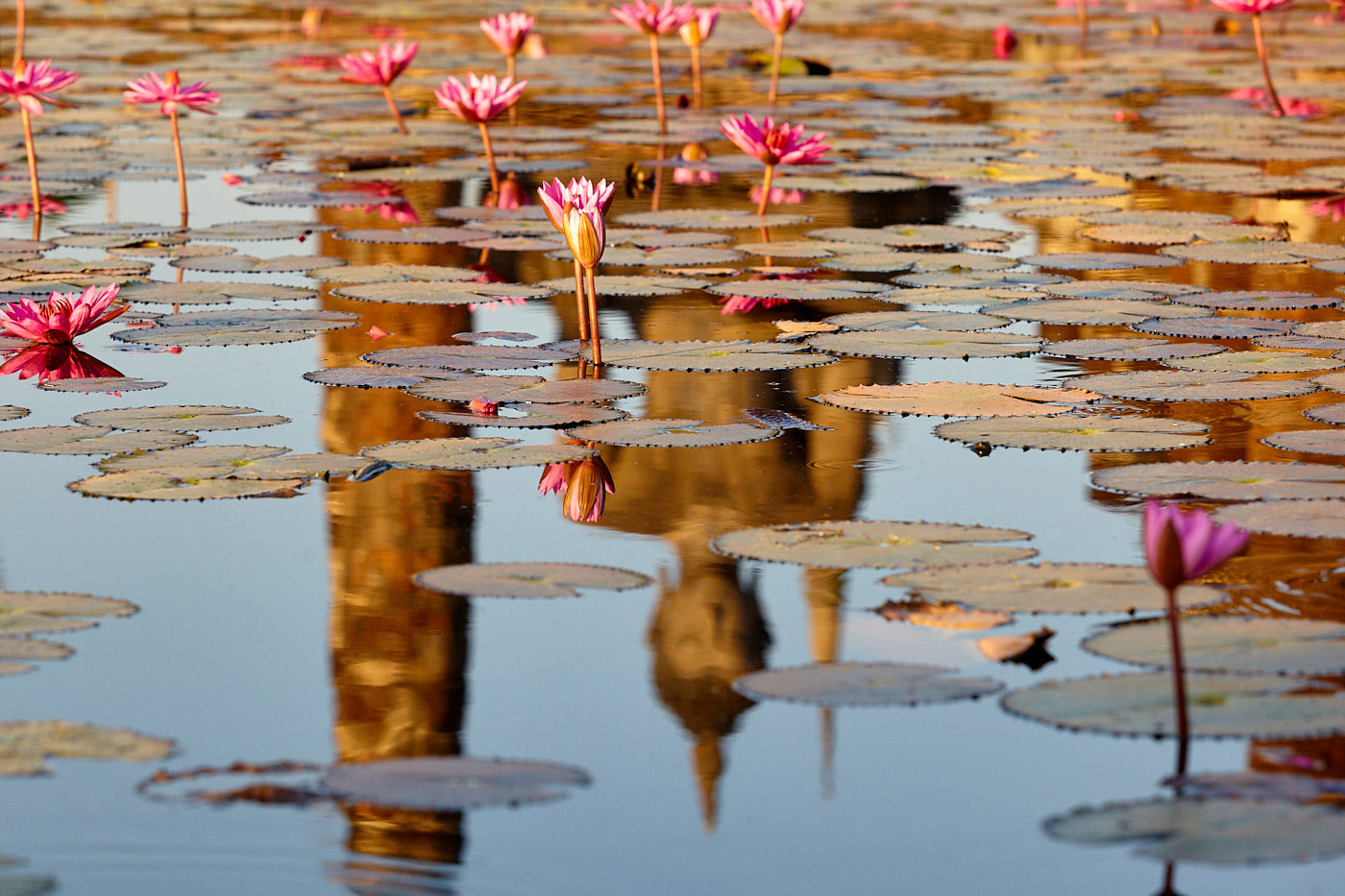
Sukhothai, The Cradle of Thai Civilisation and UNESCO World Heritage site
Lights fade through the colours of the spectrum illuminating ancient columns, music floats on the breeze punctuated by the call of frogs and cicadas. Between the columns, tourists and locals alike snap selfies amid the gentle psychedelia. Across a lotus pond, more serious photographers have staked out their territories with a forest of tripods in anticipation of a glorious sunset.
This is the scene played out every night in front of Wat Mahathat, the largest of the temple ruins at Sukhothai Historical Park in the north of Thailand. Each afternoon, from about 5.00 pm, tour buses arrive spilling out Thai and foreign visitors to witness the show.
But while the coloured lights and music may be pretty the real beauty of this UNESCO World Heritage site is revealed better in the daytime. The park opens at 6.00 am and at that time the only people you’ll have to share the place with are a few early morning joggers. The inner area is easy to walk around but bicycles are also available for hire if you wish.

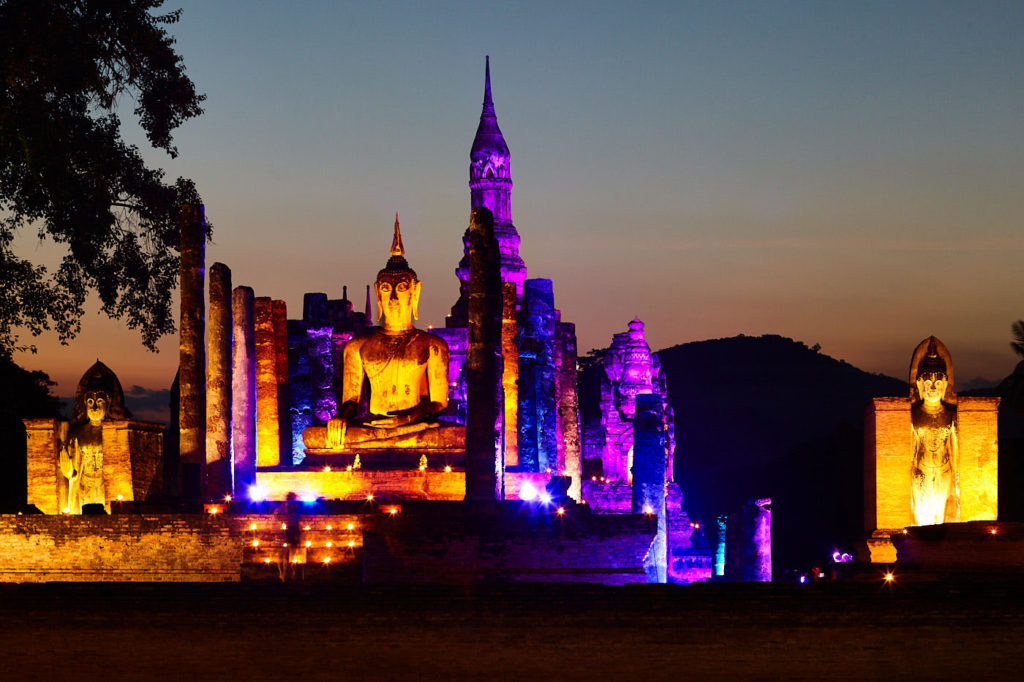
Monument to King Ramkamhaeng, the father of Thai civilisation (left). Evening light show at Wat Mahathat.
The Sukhothai era is regarded as the cradle of Thai civilisation and culture. It had originally been a trade centre and part of the Lavo Kingdom (present-day Lopburi) which was under Khmer rule. But Angkor’s influence was dwindling at the time and in 1238 two friends, Bang Klang Hao and Pha Mueang, organised a rebellion to oust the Khmer governor. Bang Klang Hao became king ruling as Si Inthrathit and founding the Phra Ruang Dynasty. His two sons Ban Mueang and Ramkamhaeng set about expanding the new Kingdom.
See also:
Historic towns of the Sukhothai Kingdom
Simian City: The Monkeys of Lopburi
Ban Mueang succeeded his father but his reign appears to have been quite short. Ramkamhaeng ascended the throne in 1279 and it was under him the kingdom flourished. He is credited with creating the Thai alphabet, introducing Theravada Buddhism as the state religion and importing the techniques to make high-quality Sangkhalok ceramic ware.
There is a monument to Ramkamhaeng to the right after a short avenue beyond the main entrance to the park. Although it was made as recently as 1969, it is still very much revered by the Thai people.
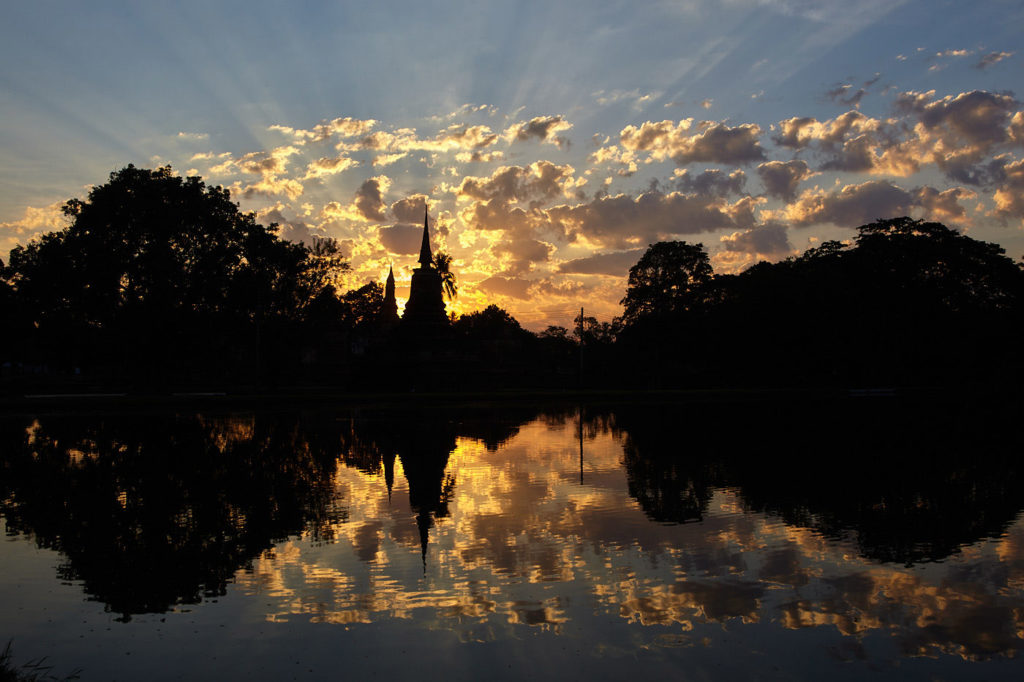
Dawn breaks over Sukhothai’s lotus ponds.
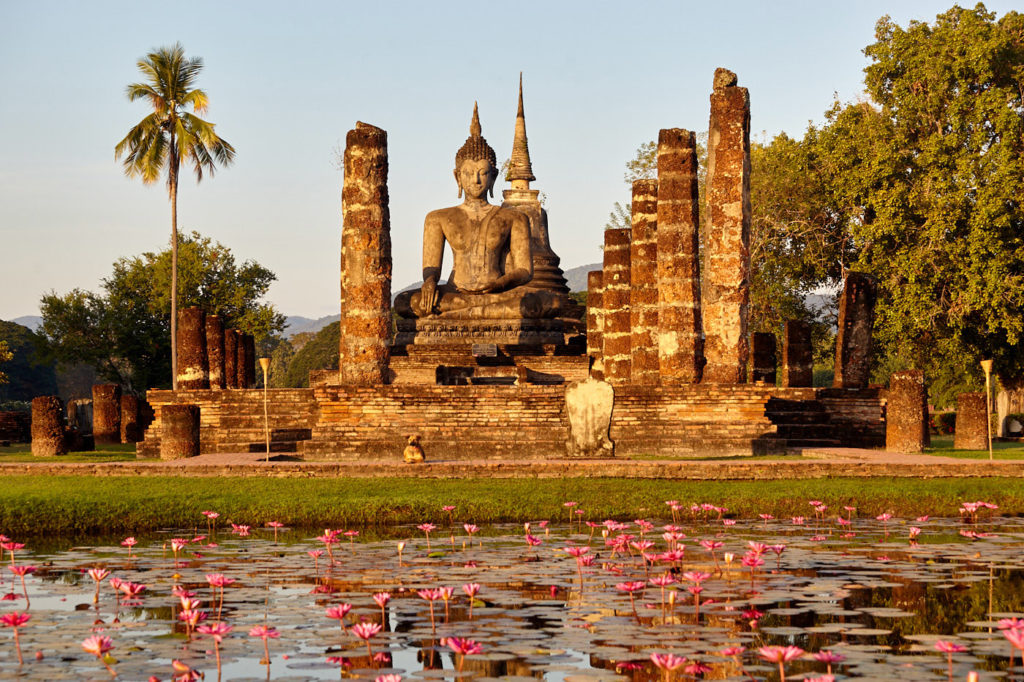
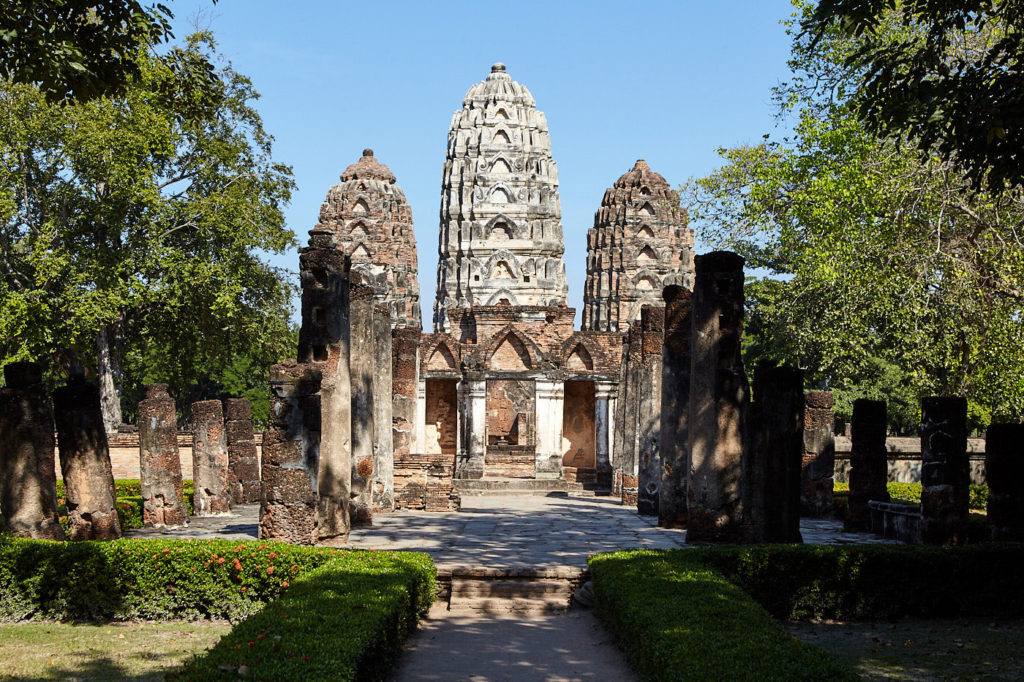
Wat Mahathat (left) and The three Khmer style prangs of Wat Si Sawai.
Turning left, away from Ramkamhaeng’s statue, along the same avenue leads to Wat Mahathat. The name means Temple of the Great Relic and is the largest and most important of all the temples at Sukhothai. It was founded in 1292 but construction probably continued for a number of years. It is believed the graceful lotus bud chedi was added around 1345 to house relics of the Buddha. The base of the chedi features stuccoed sculptures of monks and pilgrims beneath reliefs of scenes from the life of Buddha.
Around the main chedi are eight smaller chedis, the four corners in Mon style, the others Khmer influenced. In front of the lotus bud chedi is a large Buddha in the Bhumisparsha mudra or the earth witness position which commemorates the Buddha’s victory over the temptation by the demon King Mara. Flanking it are two mandapas housing nine metre tall standing Buddha images. Another large chedi contains the remains of King Loe Thai, Ramkamhaeng’s son who reigned from 1298 to 1323. Surrounding the complex are numerous lotus ponds whose flowers open with the morning sun.
To the southwest of Wat Mahathat is Wat Si Sawai which was originally built as a Hindu sanctuary dedicated to Shiva before the founding of Sukhothai. It features three Khmer-style prangs adorned with stuccoed carvings of mythological creatures.
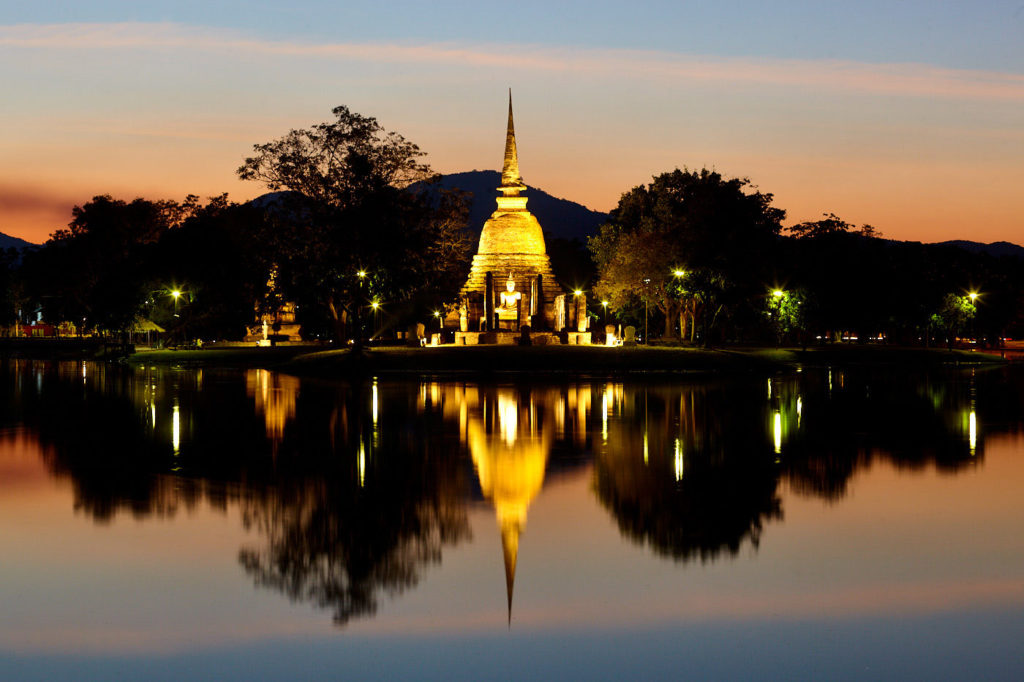
Wat Sa Si. Thanks to its location this is probably the prettiest temple in Sukhothai.
Wat Sa Si, to the northwest of Wat Mahathat, is perhaps the prettiest of the smaller temples. It sits on a small island surrounded by trees in the middle of a lotus-filled lake called Tra Phang Tra Kuan. The temple was founded during the fourteenth century and features both seated and walking Buddha images. In the evening the illuminated chedi is reflected on the surface of the lake and offers a much less crowded alternative to Wat Mahathat.
Beyond the old city
There are more temples in the main park area set between lotus ponds and neatly clipped lawns where you can sit in the shade of a tree and soak up the atmosphere. For the energetic, there are more ruins beyond the city walls. A bicycle really is the best way to visit these.
As you approach the entrance to the inner park area, instead of going in turn right and follow the road around the perimeter. There are two right turns; the first will lead to Wat Sorasak, recognisable by the chedi with the elephants around its base. The second, immediately after, leads through San Luang Gate in the north wall.
Wat Phra Phai Luang is on the left and can be reached by a bridge over a rather marshy patch of ground which was once a double moat. It’s a sprawling complex and since this is the rear entrance it is about 500 metres to the front. Only one of its original three prangs remains to testify of its Khmer origins. Probably built in the late 12th century this was once the ceremonial centre of the city but fell into disuse after liberation from Khmer rule. The temple was converted to Theravada Buddhism and, in the fourteenth century, the mandapa was added though evidence of only walking and standing Buddhas remain.
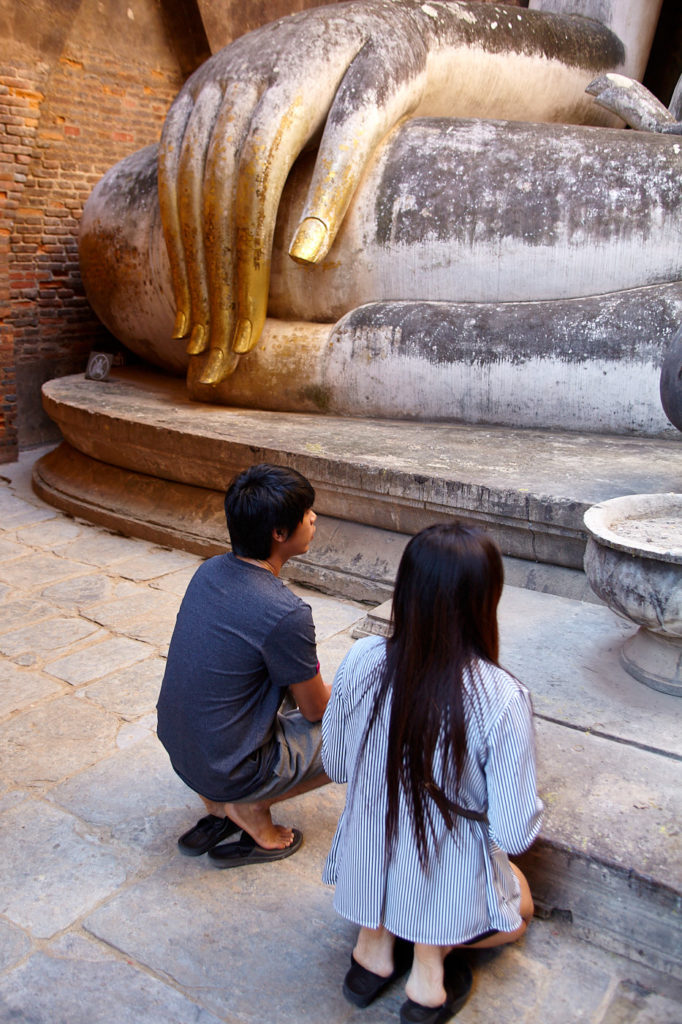
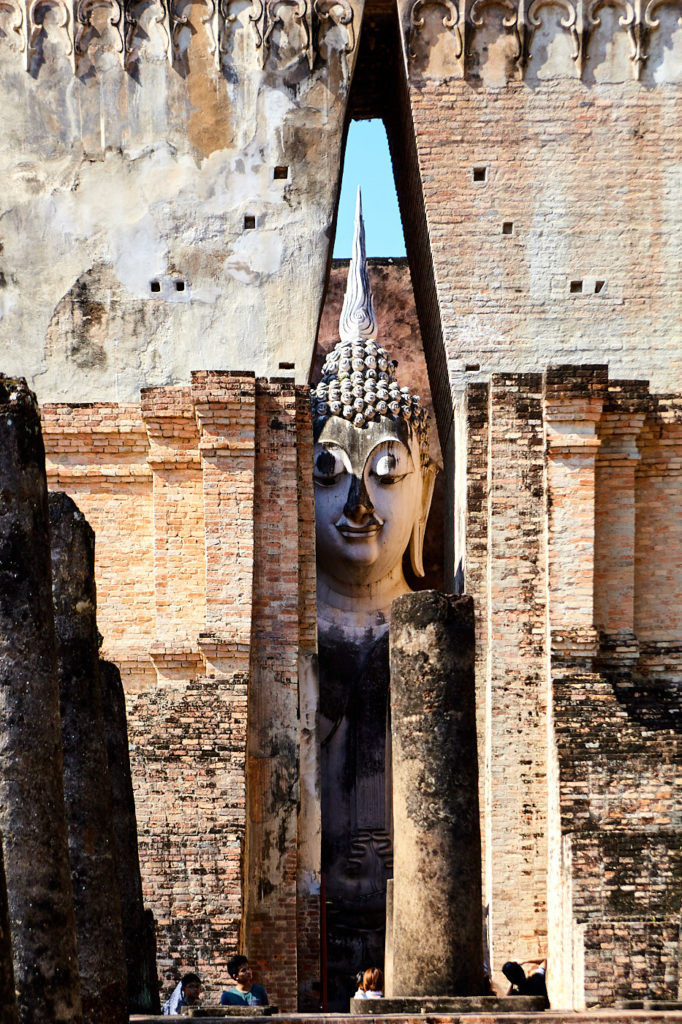
Paying respects to the 15 metre Buddha at Wat Si Chum (left). The view from outside the mandapa
A short ride from Wat Phra Phai Luang is Wat Si Chum. Built in the late fourteenth century the striking feature here is a huge mandapa enclosing one of the most revered Buddha images in Sukhothai. As you approach you see just a small portion of the Buddha through the narrow opening. Stepping inside reveals a 15-metre-high image, known as Phra Ajana, in the subduing Mara position. The gold leaf on its right hand is a testament to the reverence with which it is held.
On the south wall is a narrow staircase that, though not open to the public, leads to the roof. The stairway was decorated with fifty slates which are the oldest surviving examples of Thai drawing. These are now kept at the Ram Khamhaeng National Museum. An old legend claims that the King of Sukhothai, in order to boost morale, would climb the staircase and speak to his subjects and armies through a hole thus giving the impression that it was the Buddha speaking.
From Wat Si Chum the road leads to the main road where a left turn leads back towards Sukhothai.
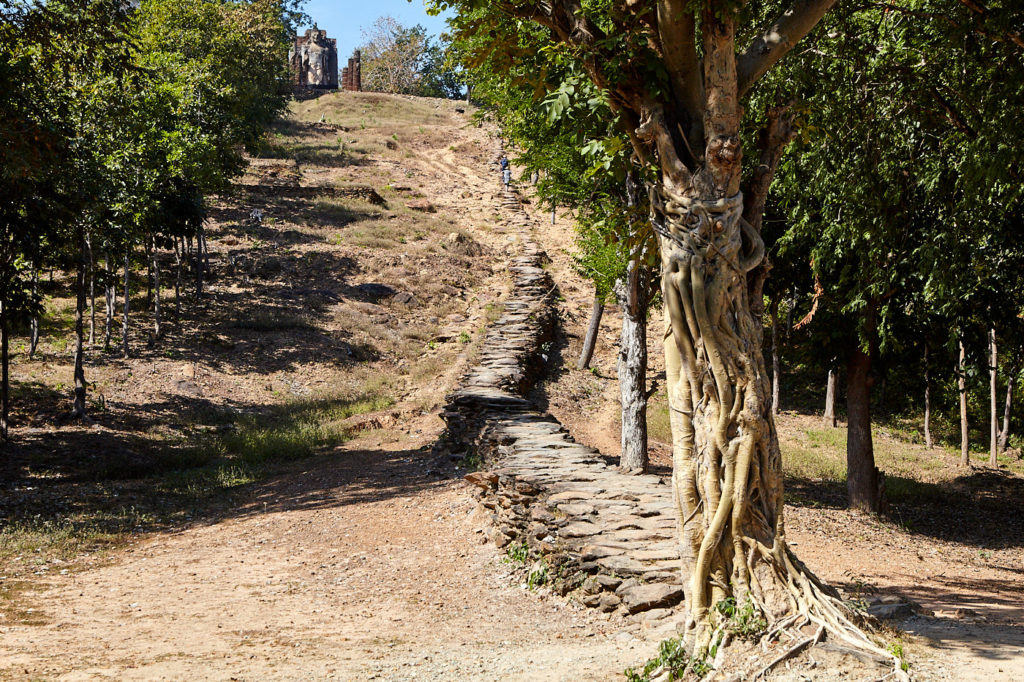
The forest temples are an excellent place to soak up a little nature and indulge in a little contemplation. Above, Wat Saphan Hin. Below, Wat Khao Phra Bat Noi. (left) and Wat Chedi Ngam.

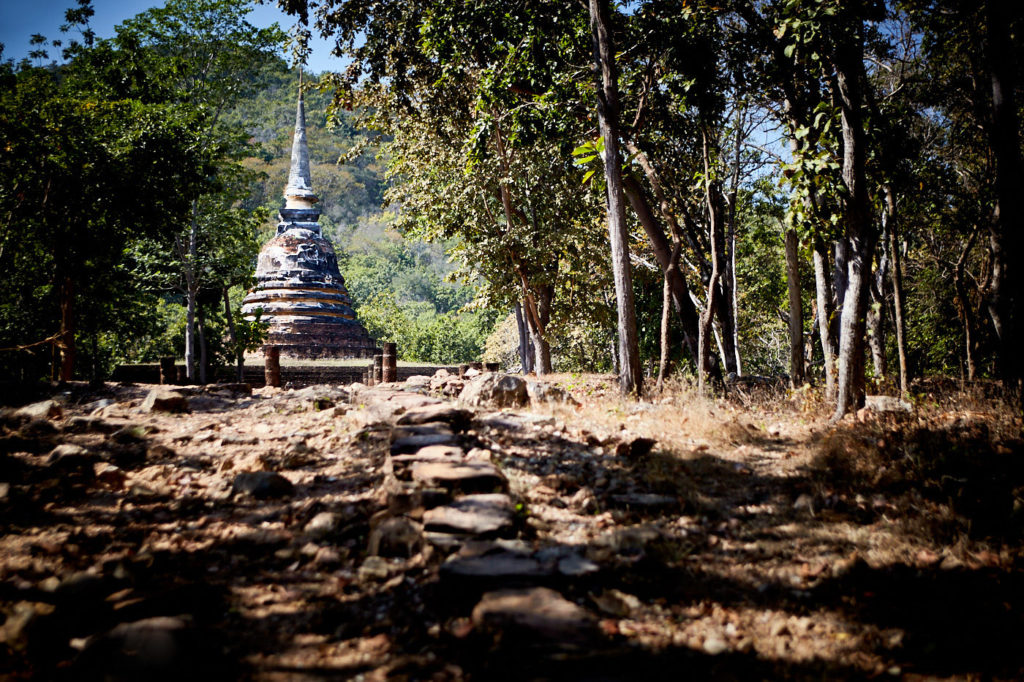
Turn right here and after about a kilometre there is a small turning to the left with a sign pointing to Wat Saphan Hin. The name means stone bridge temple. It is built on a hill overlooking the plain of Sukhothai and is reached via a 300-metre-long slate path. At the top, there is a prayer hall with a 12.5 metre standing Buddha called Phra Attharot. The statue itself is in a poor state of repair and has had to be reinforced from the rear to stop it from falling over completely. Hopefully, it can be restored soon. The view looking back over the plain is quite beautiful. It is believed that Ramkamhaeng himself would come here to pay his respects on Buddhist holy days.
There are around 15 more temples in the area south of here known collectively as The Forest Temples. These gently wooded slopes must have offered an ideal environment to practice a Buddhist way of life. Although parts of the forest have given way to agriculture and many of the ruins are little more than piles of bricks or remnants of chedis it is the journey, not the destination that counts. Sitting mindfully by the side of a crumbling chedi or gliding silently along on a bicycle, past dark woods one moment to fields of sugarcane and cassava the next, makes for a very peaceful and relaxing day.
So intersting to read about the connections of Angkor and that place. If we only could travel through time. Would be interesting to see it with own eyes. Great photos on top.
All of the major sites across Southeast Asia are connected throughout history. It’s fascinating to look at the various kingdoms and empires and the relationships they had with each other as they expanded and then faded.